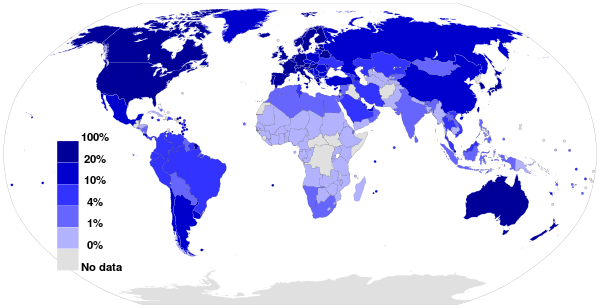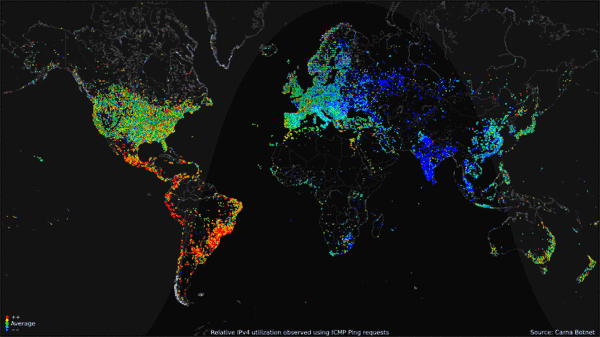This article on global Internet usage includes tables, charts, maps, and a list of articles with more detailed information on a wide range of usage measures.
Internet users

Internet users per 100 inhabitantsSource: International Telecommunications Union.[1][2]
Worldwide Internet users
| | 2005 | 2010 | 2013a |
| World population[1] |
6.5 billion |
6.9 billion |
7.1 billion |
| Not using the Internet |
84% |
70% |
61% |
| Using the Internet |
16% |
30% |
39% |
| Users in the developing world |
8% |
21% |
31% |
| Users in the developed world |
51% |
67% |
77% |
a Estimate.
Source: International Telecommunications Union.[2] |
|
Internet users by region
| |
2005b |
2010b |
2013a,b |
| Africa |
2% |
10% |
16% |
| Americas |
36% |
49% |
61% |
| Arab States |
8% |
26% |
38% |
| Asia and Pacific |
9% |
23% |
32% |
Commonwealth of
Independent States |
10% |
34% |
52% |
| Europe |
46% |
67% |
75% |
a Estimate. b Per 100 inhabitants.
Source: International Telecommunications Union.[2] |
|
|
Broadband usage
Worldwide broadband subscriptions
| |
2007a |
2010a |
2013a,b |
| World population |
6.6 billion |
6.9 billion |
7.1 billion |
| Fixed broadband |
5.2% |
7.6% |
9.8% |
| Developing world |
2.3% |
4.2% |
6.1% |
| Developed world |
18.0% |
23.6% |
27.2% |
| Mobile broadband |
4.0% |
11.3% |
29.5% |
| Developing world |
0.8% |
4.4% |
19.8% |
| Developed world |
18.5% |
42.9% |
74.8% |
a Per 100 inhabitants. b Estimate.
Source: International Telecommunications Union.[2] |
|
|
Broadband subscriptions by region
| Fixed subscriptions: |
2007a |
2010a |
2013a,b |
| Africa |
0.1% |
0.2% |
0.3% |
| Americas |
10.9% |
14.1% |
17.1% |
| Arab States |
0.9% |
1.9% |
3.3% |
| Asia and Pacific |
3.2% |
5.5% |
7.6% |
Commonwealth of
Independent States |
2.3% |
8.2% |
13.5% |
| Europe |
18.4% |
23.6% |
27.0% |
| Mobile subscriptions: |
2007a |
2010a |
2013a,b |
| Africa |
0.2% |
1.8% |
10.9% |
| Americas |
6.4% |
22.9% |
48.0% |
| Arab States |
0.8% |
5.1% |
18.9% |
| Asia and Pacific |
3.1% |
7.4% |
22.4% |
Commonwealth of
Independent States |
0.2% |
22.3% |
46.0% |
| Europe |
14.7% |
28.7% |
67.5% |
a Per 100 inhabitants. b Estimate.
Source: International Telecommunications Union.[3][2] |
|
Internet hosts
IPv4 addresses
The Carna Botnet was a botnet of 420,000 devices created by hackers to measure the extent of the Internet in what the creators called the “Internet Census of 2012”.[4][5]
Languages
Censorship
Internet users in Europe
See also
References
- ↑ "Total Midyear Population for the World: 1950-2050", International Programs Center for Demographic and Economic Studies, U.S. Census Bureau, Retrieved 25 May 2013
- ↑ 2.0 2.1 2.2 2.3 "Key ICT indicators for developed and developing countries and the world (totals and penetration rates)", International Telecommunications Unions (ITU), Geneva, 27 February 2013
- ↑ "Key Global Telecom Indicators for the World Telecommunication Service Sector", International Telecommunications Unions (ITU), Geneva, 2011
- ↑ Stöcker, Christian; Horchert, Judith (2013-03-22). "Mapping the Internet: A Hacker's Secret Internet Census". Spiegel Online.
- ↑ Kleinman, Alexis (2013-03-22). "The Most Detailed, GIF-Based Map Of The Internet Was Made By Hacking 420,000 Computers". Huffington Post.
- ↑ Source: InternetWorldStats for countries of Europe, Asia updated for June 30, 2012
External links
|
|---|
| | Sovereign states |
- Algeria
- Angola
- Benin
- Botswana
- Burkina Faso
- Burundi
- Cameroon
- Cape Verde
- Central African Republic
- Chad
- Comoros
- Democratic Republic of the Congo
- Republic of the Congo
- Djibouti
- Egypt
- Equatorial Guinea
- Eritrea
- Ethiopia
- Gabon
- The Gambia
- Ghana
- Guinea
- Guinea-Bissau
- Ivory Coast (Côte d'Ivoire)
- Kenya
- Lesotho
- Liberia
- Libya
- Madagascar
- Malawi
- Mali
- Mauritania
- Mauritius
- Morocco
- Mozambique
- Namibia
- Niger
- Nigeria
- Rwanda
- São Tomé and Príncipe
- Senegal
- Seychelles
- Sierra Leone
- Somalia
- South Africa
- South Sudan
- Sudan
- Swaziland
- Tanzania
- Togo
- Tunisia
- Uganda
- Zambia
- Zimbabwe
|
|---|
| |
- Sahrawi Arab Democratic Republic
- Somaliland
|
|---|
| |
- Canary Islands / Ceuta / Melilla / Plazas de soberanía (Spain)
- Madeira (Portugal)
- Mayotte / Réunion (France)
- Saint Helena / Ascension Island / Tristan da Cunha (United Kingdom)
|
|---|
|
|
|---|
|
- North America
- South America
| | | Sovereign states |
- Antigua and Barbuda
- Argentina
- Bahamas
- Barbados
- Belize
- Bolivia
- Brazil
- Canada
- Chile
- Colombia
- Costa Rica
- Cuba
- Dominica
- Dominican Republic
- Ecuador
- El Salvador
- Grenada
- Guatemala
- Guyana
- Haiti
- Honduras
- Jamaica
- Mexico
- Nicaragua
- Panama
- Paraguay
- Peru
- Saint Kitts and Nevis
- Saint Lucia
- Saint Vincent and the Grenadines
- Suriname
- Trinidad and Tobago
- United States
- Uruguay
- Venezuela
| |
|---|
| |
- Anguilla
- Aruba
- Bermuda
- Bonaire
- British Virgin Islands
- Cayman Islands
- Curaçao
- Falkland Islands
- French Guiana
- Greenland
- Guadeloupe
- Martinique
- Montserrat
- Navassa Island
- Puerto Rico
- Saint Barthélemy
- Saint Martin
- Saint Pierre and Miquelon
- Saba
- Sint Eustatius
- Sint Maarten
- South Georgia and the South Sandwich Islands
- Turks and Caicos Islands
- US Virgin Islands
|
|---|
|
Internet in Europe |
|---|
| | Sovereign states | |
|---|
| |
- Abkhazia
- Kosovo
- Nagorno-Karabakh
- Northern Cyprus
- South Ossetia
- Transnistria
|
|---|
| |
- Åland
- Faroe Islands
- Gibraltar
- Guernsey
- Jersey
- Isle of Man
- Svalbard
|
|---|
|
Internet in Oceania |
|---|
| | Sovereign states |
- Australia
- Cook Islands
- Fiji
- Kiribati
- Marshall Islands
- Federated States of Micronesia
- Nauru
- New Zealand
- Niue
- Palau
- Papua New Guinea
- Samoa
- Solomon Islands
- Tonga
- Tuvalu
- Vanuatu
|
|---|
| |
- American Samoa
- Christmas Island
- Cocos (Keeling) Islands
- Easter Island
- French Polynesia
- Guam
- Hawaii
- New Caledonia
- Norfolk Island
- Northern Mariana Islands
- Pitcairn Islands
- Tokelau
- Wallis and Futuna
|
|---|
|
|
|---|
| | Indices | |
|---|
| | Internet | |
|---|
| | Phones | |
|---|
| | Other | |
|---|
| |
|












.svg.png)